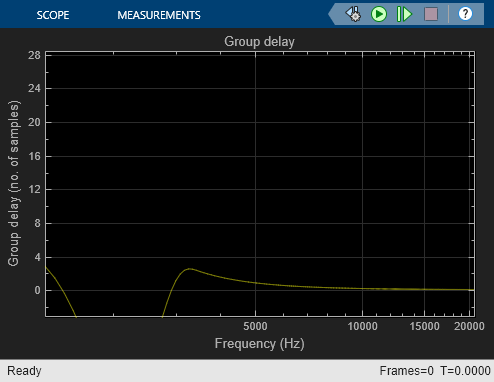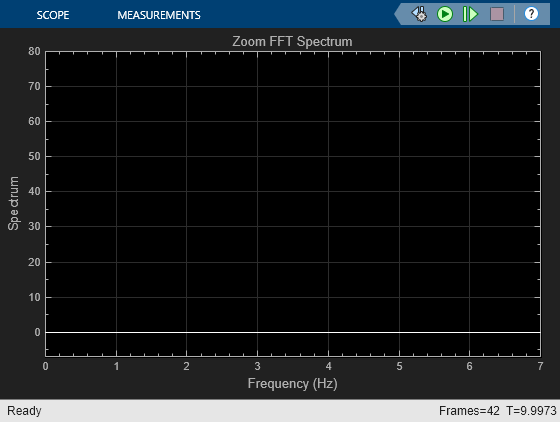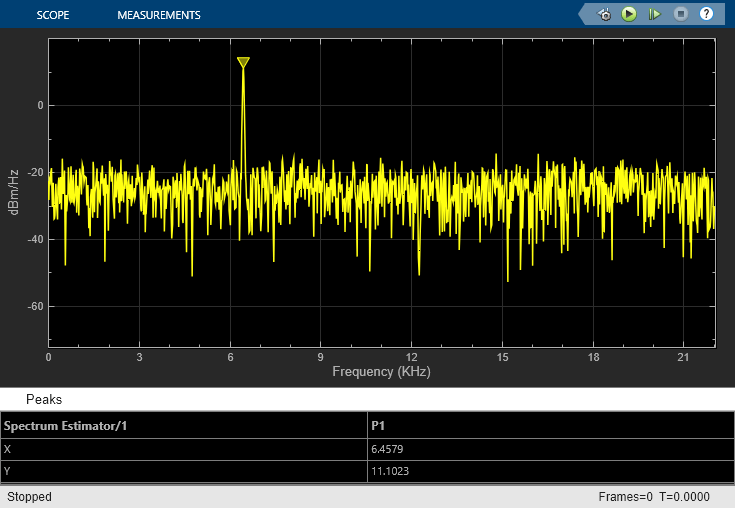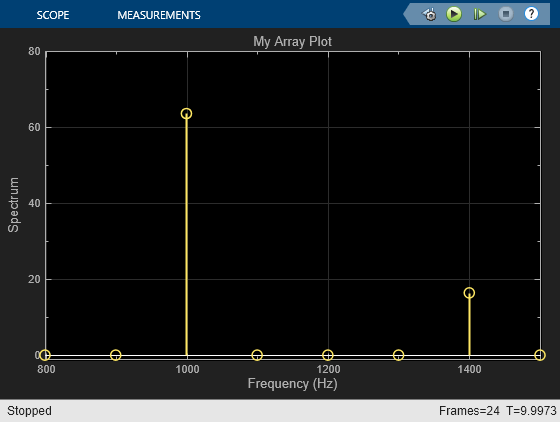Array Plot
Display vectors or arrays
Libraries:
DSP System Toolbox /
Sinks
Description
The Array Plot block plots vectors or arrays of data.

The Array Plot is a vector plot where data is uniformly spaced along
the x-axis. To modify the spacing, change the Sample
Increment property.
Measurements available:
Data Cursors — Measure signal values using vertical and horizontal cursors.
Signal Statistics — Display the maximum, minimum, peak-to-peak difference, mean, median, and RMS values of a selected signal.
Peak Finder — Find maxima, showing the x-axis values at which they occur.
Examples
Analyze a Subband of Input Frequencies Using Zoom FFT
Compute the zoom FFT of a sine wave in Simulink®.
Active Noise Control with Simulink Real-Time
Design a real-time active noise control system using a Speedgoat® Simulink® Real-Time™ target.
(Audio Toolbox)
Streaming Power Spectrum Estimation Using Welch's Method
Use Welch's method of averaged modified periodogram to estimate power spectrum.
Configure Array Plot From the Command-Line
Change Array Plot block behavior and appearance from the command line.
Estimate Transfer Function in Simulink
To estimate the transfer function of a system in Simulink®, use the Discrete Transfer Function Estimator block. The block implements the Welch's average modified periodogram method and uses the measured input and output data for estimation.
Ports
Input
Connect the signals you want to visualize. You can have up to 96 input ports. Input signals must have these characteristics:
Fixed number of channels, but size can be variable
Discrete, continuous, or constant sample time
Real or complex values
Floating- or fixed-point data type
2-D and nonscalar
The Array Plot block supports inputs with different frame lengths.

This block accepts fixed-point input, but converts it to
double for display.
Data Types: single | double | int8 | int16 | int32 | int64 | uint8 | uint16 | uint32 | uint64 | Boolean | fixed point | enumerated
Complex Number Support: Yes
Properties
For information about how to configure the Array Plot and use the toolstrip, see Configure Array Plot.
Scope
Select this option to show the legend on the plot. The names listed in
the legend are taken from the Channel
Names property.
From the legend, you can control which signals are visible. This control is equivalent to changing the visibility in the Color and Styling properties. In the scope legend, click a signal name to hide the signal in the scope. To show the signal, click the signal name again. To show only one signal, right-click the signal name, which hides all other signals. To show all signals, press Esc.
Note
The legend only shows the first 20 signals. Any additional signals cannot be controlled from the legend.
Tunable: Yes
Programmatic Use
Block Parameter:
ShowLegend |
| Type: logical |
Since R2024b
Click Display Grid and select a grid to specify the layout of the display. When you select a 2-by-2 layout, for example, the scope shows four displays arranged in a 2-by-2 matrix. The grid can have a maximum of five rows and five columns.
If you create a grid of multiple axes, to modify the settings of the individual axes, use the Active Display property in the Array Plot settings.
Tunable: Yes
Programmatic Use
Block Parameter:
LayoutDimensions |
| Type: character vector or string scalar |
| Values: two-element vector |
Click this button to copy the scope display to the clipboard. You can preserve the color in the display by selecting Preserve Colors in the Copy to Clipboard drop down.
When you copy the display to the clipboard using the Copy to Clipboard and the Print options in the Scope tab > Share section, select this parameter for the scope to preserve the colors.
To access Preserve Colors, click the drop-down arrow for Copy to Clipboard.
Tunable: Yes
Click this button to save the scope display as an image or a PDF or to print the display.
Measurements
For more information about the measurements, see Use Array Plot Measurements.
Settings
Data and Axes
Select the type of spacing to use between x-axis data values.
Increment and Offset — Use the Sample Increment and X-Offset values to specify x-axis data.
Custom — Specify a custom spacing between data values using the Custom X-Data property.
Programmatic Use
Block Parameter:
XDataMode |
| Type: character vector or string scalar |
Values:
'Sample increment and X-offset' |
'Custom' |
Specify the spacing between samples along the x-axis as a finite numeric scalar. The input signal is only y-axis data. x-axis data is set automatically based on both the Sample Increment and X-Offset values.
Example: When X-Offset is 0 and Sample Increment is 1, the x-axis values are set to 0, 1, 2, 3, 4, … .
Example: When X-Offset is -1 and Sample Increment is 0.25, the x-axis values are set to -1, -0.75, -0.5, -0.25, 0, … .
Tunable: Yes
Dependencies
To use this property, set X-Data Mode to Increment and Offset.
Programmatic Use
Block Parameter:
SampleIncrement |
| Type: character vector or string scalar |
| Values: scalar |
Specify the offset to apply to the x-axis, as a numeric scalar. x-axis data is set automatically based on both the Sample Increment and X-Offset values. The x-offset represents the first value on the x-axis.
Example: When X-Offset is 0 and Sample Increment is 1, the x-axis values are set to 0, 1, 2, 3, 4, … .
Example: When X-Offset is -1 and Sample Increment is 0.25, the x-axis values are set to -1, -0.75, -0.5, -0.25, 0, … .
Tunable: Yes
Dependencies
To use this property, set X-Data Mode to Increment and Offset.
Programmatic Use
Block Parameter:
XOffset |
| Type: character vector or string scalar |
| Values: scalar |
Specify the x-axis data values as a vector equal in length to the frame length of the inputs. If you use the default (empty vector) value, the x-axis data is uniformly spaced over the interval (0:L-1), where L is the frame length.
Example: A custom logarithmic x-axis data scaling is
[0:log10(44100/2):1024]
Tunable: Yes
Dependencies
To use this property, set X-Data Mode to Custom.
Programmatic Use
Block Parameter:
CustomXData |
| Type: character vector or string scalar |
| Values: scalar |
Default:
'[]' |
The number of input ports to the block, specified as an integer between 1 and 96. To change the number of input ports, drag a new input signal line to the block and the block automatically creates new ports.
Programmatic Use
Block Parameter:
NumInputPorts |
| Type: character vector or string scalar |
| Values: scalar between 1 and 96 |
Select this parameter to automatically open the Array Plot window when you run the simulation.
Tunable: Yes
Programmatic Use
Block Parameter:
OpenAtSimulationStart |
| Type: logical |
Display and Labels
Select Linear or Log as the
x-axis scale.
Tunable: Yes
Dependencies
If X-Offset is a negative value, you cannot
set this parameter to Log.
Programmatic Use
Block Parameter:
XScale |
| Type: character vector or string scalar |
Select Linear or Log as the
y-axis scale.
Tunable: Yes
Programmatic Use
Block Parameter:
YScale |
| Type: character vector or string scalar |
Since R2024b
Specify the precision of numeric values in the scope display as a positive integer in the range [1, 15].
Tunable: Yes
Since R2024b
Specify the active display as an integer display number. The settings in the Y-Limits, X-Label, Y-Label, Show Legend, Show Grid, Title, and Magnitude Phase Plot properties affect only the active display.
The number of the display corresponds to the row-wise placement index of the display. To control the layout of the display, click Display Grid in the Scope tab and select a layout.
Tunable: Yes
Programmatic Use
Block Parameter:
ActiveDisplay |
| Type: character vector or string scalar |
| Values: integer display number ≥ 1 |
Specify the text for the scope to display below the x-axis.
Tunable: Yes
Programmatic Use
Block Parameter:
XLabel |
| Type: character vector or string scalar |
Default:
'' |
Specify the text to display on the y-axis. To
display signal units, add (%<SignalUnits>) to the
label. At the beginning of a simulation, Simulink replaces (%<SignalUnits>) with the
units associated with the signals.
Example: For a velocity signal with units of m/s,
enter Velocity (%<SignalUnits>).
Tunable: Yes
Dependencies
If you select Magnitude Phase Plot in the
scope settings, this property does not apply. The
y-axes are labeled
Magnitude and
Phase.
Programmatic Use
Block Parameter:
YLabel |
| Type: character vector or string scalar |
Default:
'' |
Specify a title for display. To use the input signal name for the
title, enter %<SignalLabel>.
Tunable: Yes
Programmatic Use
Block Parameter:
Title |
| Type: character vector or string scalar |
Default:
'' |
Specify the y-axis limits as a two-element numeric
vector, [ymin, ymax].
If you clear Magnitude Phase Plot, the default is
[-10,10]. If the magnitude/phase plot is on, the
default is [0,10].
Tunable: Yes
Dependencies
When you select Magnitude Phase Plot, this
property specifies the y-axis limits of only the
magnitude plot. The y-axis limits of the phase
plot are always [-180,180].
Programmatic Use
Block Parameter:
YLimits |
| Type: character vector or string scalar |
| Value: two-element numeric vector |
Since R2024b
on— The scope displays magnitude and phase plots. If the signal is real, the scope plots the absolute value of the signal for the magnitude. The phase is 0 degrees for positive values and 180 degrees for negative values. This feature is useful for complex-valued input signals. If the input is a real-valued signal, selecting this parameter returns the absolute value of the signal for the magnitude.off— The scope displays a signal plot. If the signal is complex, the scope plots the real and imaginary parts on the same y-axis.
Tunable: Yes
Programmatic Use
Block Parameter:
PlotAsMagnitudePhase |
| Type: logical |
Since R2024b
Select this parameter to display the legend in the scope.
Tunable: Yes
Programmatic Use
Block Parameter:
ShowLegend |
| Type: logical |
Select this option to show grid lines on the plot.
Tunable: Yes
Programmatic Use
Block Parameter:
ShowGrid |
| Type: logical |
Color and Styling
Specify the type of plot for each channel as one of these:
Stem— Stem graph displayed as circles at the input value with vertical lines to the x-axis.Line— Line graph.Stairs— Stair-step graph. A stair-step graph is made up of only horizontal and vertical lines. Each horizontal line represents the signal value for a discrete sample period and is connected to two vertical lines. Each vertical line represents the change in the signal value occurring at a specific sample time.Bar–– Bar plot. (since R2024b)
You can individually control the type of plot for each line. To control the type of plot for a line, select the line and set the Plot Type parameter accordingly. (since R2025a)
Tunable: Yes
Programmatic Use
Block Parameter:
PlotType |
| Type: character vector or string scalar |
Specify the font size of labels in the display as a finite positive real scalar in the range [1,100].
Tunable: Yes
Specify the background color in the scope figure.
Tunable: Yes
Specify the background color of the axes.
Tunable: Yes
Specify the color of the labels, grid, and the channel names in the legend.
Tunable: Yes
Specify the channel for which you want to modify the visibility, line color, style, width, and marker properties.
Tunable: Yes
Select this check box to display the channel you have selected. If you clear this check box, the selected channel is no longer visible. You can also click the signal name in the legend to control its visibility. For more details, see Legend.
Tunable: Yes
Specify the line style for the selected channel.
Tunable: Yes
Dependencies
To enable this property,
select Plot Type to
Bar. (since R2024b)
Specify the line width for the selected channel when you select
Plot Type to Line,
Stairs, or
Stem. The default value of line width is
1.5.
When you set Plot
Type to Bar, you can use this
property to specify the relative width of individual bars for the
selected channel. The value of this property can be a scalar in the
range [0,1]. Use this property to control the separation of bars within
a display. At the default value of 0.9, the
scope separates the bars slightly. If you set this property to
1, then adjacent bars touch. (since R2024b)
Tunable: Yes
Specify a data point marker for the selected channel. This parameter is similar to the Marker property for plots. You can choose any of the marker symbols from the drop-down list.
Tunable: Yes
Dependencies
To enable this property,
select Plot Type to
Bar. (since R2024b)
Specify the line color for the selected channel.
Tunable: Yes
Property Inspector Only
Input channel names, specified as a character vector, string, or array
of either. The names appear in the legend,
Settings, and Measurements
panels. If you do not specify names, the channels are labeled as
Channel 1, Channel 2,
etc.
Example: ["A","B"]
Dependencies
To see channel names, set Legend
to true.
Programmatic Use
Block Parameter:
ChannelNames |
| Type: cell array of character vectors or string array |
Hover over the array plot to see the maximize axes button
![]() .
.
Tunable: Yes
Programmatic Use
Block Parameter:
MaximizeAxes |
| Type: character vector or string scalar |
OnceAtStop— Scale y-axis after the simulation is finished.Manual— Manually scale y-axis range with the Scale Y-axis Limits toolbar button.Auto— Scale y-axis range during and after simulation.Updates— Scale y-axis after the number of time steps specified in the Number of Updates text box (100by default). Scaling occurs only once during each run.
Tunable: Yes
Programmatic Use
Block Parameter:
AxesScaling |
| Type: character vector or string scalar |
Set this property to delay auto scaling the y-axis.
Tunable: Yes
Dependencies
To enable this property, set Axes Scaling
to Updates.
Programmatic Use
Block Parameter:
AxesScalingNumUpdates |
| Type: character vector or string scalar |
| Values: scalar |
Block Characteristics
Data Types |
|
Direct Feedthrough |
|
Multidimensional Signals |
|
Variable-Size Signals |
|
Zero-Crossing Detection |
|
Extended Capabilities
This block can be used for simulation visibility in systems that generate code, but is not included in the generated code.
Version History
Introduced in R2015bYou can now individually control the type of plot for each line. To control the type of plot for a line, select the line and set the Plot Type parameter accordingly.
The Array Plot block now supports bar plots. To view data using a
bar plot, set Plot Type to Bar in
Array Plot settings > Color and Styling.
Click the new Display Grid property in the Scope tab to specify the layout of the Array Plot scope display. When you select a 2-by-2 layout, for example, the scope shows four displays arranged in a 2-by-2 matrix. The display grid can have a maximum of five rows and five columns.
You can now specify the active display using the Active Display property in the Array Plot settings > Display and Labels. The settings in the Y-Limits, X-Label, Y-Label, Show Legend, Show Grid, Title, and Magnitude Phase Plot properties affect only the active display.
You can now increase the display precision to 15 digits using the Display Precision property in the scope settings under Display and Labels. This precision affects all the measurements and data that the scope displays on its status bar.
The Preserve colors for copy to clipboard property has been renamed to Preserve Colors and is now available in the scope toolstrip under Copy Display.
The Magnitude Phase property has been renamed to Magnitude Phase Plot and is now available in the Array Plot settings > Display and Labels.
The Show Legend property is now also available in the Array Plot settings > Display and Labels. To control the legend display, you can select Legend in the Scope tab of the Array Plot toolstrip or select the Show Legend property.
The Plot tab in array plot has been renamed as Scope tab.
See Also
Blocks
Objects
MATLAB Command
You clicked a link that corresponds to this MATLAB command:
Run the command by entering it in the MATLAB Command Window. Web browsers do not support MATLAB commands.
Select a Web Site
Choose a web site to get translated content where available and see local events and offers. Based on your location, we recommend that you select: .
You can also select a web site from the following list
How to Get Best Site Performance
Select the China site (in Chinese or English) for best site performance. Other MathWorks country sites are not optimized for visits from your location.
Americas
- América Latina (Español)
- Canada (English)
- United States (English)
Europe
- Belgium (English)
- Denmark (English)
- Deutschland (Deutsch)
- España (Español)
- Finland (English)
- France (Français)
- Ireland (English)
- Italia (Italiano)
- Luxembourg (English)
- Netherlands (English)
- Norway (English)
- Österreich (Deutsch)
- Portugal (English)
- Sweden (English)
- Switzerland
- United Kingdom (English)






